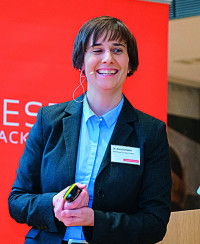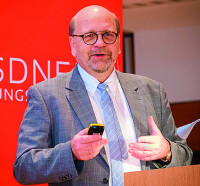The 28th Dresden Packaging Conference was held under the motto “Packaging Discussion – Contradictions as a Driver of Innovation.” With the new packaging ordinance in the background, seminars from top-class presenters, including the German NABU (Nature and Biodiversity Conservation Union) and the German Consumer Initiative, were hotly discussed.
By Alfons Strohmaier
Winfried Batzke, Managing Director of the German Packaging Institute (dvi), has a lovely habit of sharing historical facts and personalities in connection with the convention host city of Dresden. He recalled the German painter and sculptor Käthe Kollwitz, who found sanctuary in 1945 at Moritzburg Castle with Princess Virginia and Prince Ernst Heinrich von Sachsen. The dvi Director and moderator cited the artist, saying, “I want to be active during this time, in which people are desperate and in need,” adding that the packaging sector was currently “rather desperate and in need.“ The packaging market is unsettled pri-marily due to the numerous, as yet unclear details in the packaging ordinance that entered into force on 1 January 2019.
Uwe Streiber, Director of Packaging Management at Zalando, reported that the company is not yet certain how packaging cartons and bags returned by consumers will be handled under the new law. With over 80 million packages each year and a return rate of 50 %, the question of licencing is significant for management. In his seminar titled “Between Personal Customer Experience, Productivity Goals and Sustainability: How Packaging Contributes,” Streiber surprised with the statement that automation in Zalando‘s hub and spoke network is zero. Packaging optimization focuses on internal processes, through which the setup time for employees folding cartons was able to be reduced by half. When a participant asked about standardized, reusable plastic boxes in shipping, the expert replied that such a system already exists in Sweden and that the responsible parties are “watching this development.”
Martin Hammer, New Business Development Manager, and Rüdiger Nölleke, Sales Director at Stora Enso Germany GmbH, described the transformation of the Finnish-Swedish company Stora Enso twelve years ago, the proportion of paper production was around 70 %, and today it is only 30 %. Stora Enso is the only company to offer microfibrillated cellulose (MFC) made from wood pulp; due to its fineness, it can be used as a base for various materials in automobiles, aircraft, wind power generators, as well as in films. “MFC will replace many barrier films in the future,” stated Hammer confidently. Stora Enso stands not just for recycling, but also for the renewables, said Nölleke. When asked about grass, hemp and straw as a source material for cellulose, the managers referenced the factory structures with equipment that processes massive volumes and is not suitable for niche markets.
“We are on a journey.” This statement from the representatives from Stora Enso likely applies for the entire sector. This trend continued on the second day as well, during which presenters undertook a critical assessment of the new packaging ordinance from various perspectives. Katharina Istel, the presenter on resource politics from NABU, issued a reminder that the fight against climate change is not the only problem. One must consider everything in the ecological balance; it is also about biodiversity, habitat protection, and species diversity. Sustainable resources remain a contributor to industrial agriculture, such as intensive corn crops. In general, the issue is about prevention and not just recycling, as products made in Germany are delivered around the world. More than three billion people worldwide have no access to functioning waste disposal. Since 1995, packaging waste has increased by enormous 31 %.
Deficits with regard to definitions and legal grey areas in the new German Packaging Act, valid from 1 January 2019, were presented by Dr Hans-Bernhard Rhein, Managing Partner of the environmental office Dr Rhein – Beratungs- und Prüfgesellschaft. As an authority expert, he took part in an extremely critical report on the packaging ordinance, which has been kept under tight wraps at the German Federal Environmental Agency since March. For example, § 21 speaks of “high recyclability,” “use of recycled material,” “quality,” and renewable resources. Depending on the ecologic setup, varying participation fees would result. “But what does this actually mean? Who determines this?,” the speaker vividly asked.
Thomas Reissig demonstrated how VerDeSoft GmbH creates packaging agilely and flexibly directly at the customer's site – based on SCRUM framework. At the end of the two-day event in Dresden, each participant received a packaging developed on site with their individual name.
Dr Kerstin Horn, Innovent e. V., informed about plasma technology. Innovent is dedicated to developing value-adding and innovative plasma technologies for surface treatment of polymeric materials, also used for applications in the packaging industry. As usual, there were many practical presentations, for instance new methods for adhesives (Baumer hss), sealing with ultrasound (Herrmann Ultraschalltechnik), consistent colour management (Matthews Europe), and much more at the conference.
http://www.verpackungstagung.de









